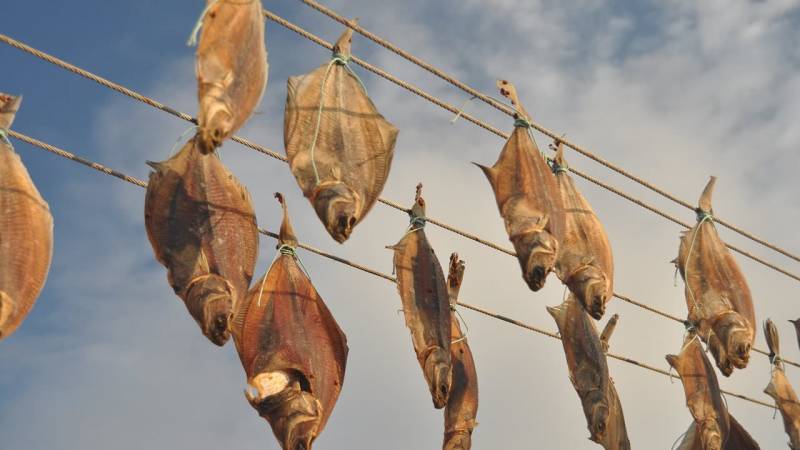
How to make dried fish? Find all needed instructions!
Dried fish (stockfish) is a great way to preserve fish.
With this, you can create a supply of food in the wilderness.
In this article, you will learn what you need to consider as a bushcrafter and how the production works.
Which fish is suitable?
Not every fish is suitable for drying.
Do not use fatty fish for drying. It does not work with halibut, salmon, herring, or mackerel. The fat will turn rancid and the fish will be inedible.
Drying only works with lean fish. For example:
- Flounder
- Codfish
- Pollock
- Saithe
Note also that low-fat fish is not as rich in calories as fatty fish. However, you will take in lots of protein with dried fish.
Here you can see fresh codfish:
![Wie du Trockenfisch herstellst [Anleitung und Infos] codfish](https://survival-kompass.de/img/artikel/kabeljau.jpg)
But not everyone lives near the sea.
There are also freshwater fish that are good for drying. These are:
- Bream
- Pike-perch
- Trout (if not too fatty)
- Roach
- Rudd
- Prussian carp
- Tench
- Perch
You can find these fish in almost every freshwater. Especially, perch are widespread.
Preparation for drying
If you have a whole fish, remove all the guts and the head. Then remove as many bones as possible, or cut the fish into fillets.
You can then salt the fish. However, it also works without salt. Depending on how the fish should taste later, it is a personal preference.
Then you open the fish like a butterfly and stretch the belly flaps with skewers.
Alternatively - if you have fillets - drill a hole and hang it on a string.
![Wie du Trockenfisch herstellst [Anleitung und Infos] Dried fish](https://survival-kompass.de/img/artikel/getrockneter-fisch.jpg)
What requirements do you need?
The humidity and wind play a big role in drying fish.
The humidity must be low (dry air). And you require wind to dry it.
Therefore, it is difficult to dry fish in many places in Germany. It works best in the Baltic or North Sea.
However, it is always worth a try. In any case, make sure that a constant and light airflow is present.
Care during drying
At night, you need to bring the fish to a dry room, as it will become moist again due to dew and hoarfrost.
The biggest enemies are flies and other insects. They dive onto food in the sun and want to lay their eggs.
If you observe flies on the fish, you need to search for eggs and remove them.
However, you only have to take care of the fish intensively in the first few days.
Because after one or two days, the fish develops a firm skin, and then flies cannot harm it anymore.
Tip: if you are not in the wilderness, you can also hang the fish in a box that is covered with fine fly screen. This way, no flies or other animals can get to the fish.
![Wie du Trockenfisch herstellst [Anleitung und Infos] Fish hung up](https://survival-kompass.de/img/artikel/getrockneter-fisch-aufgehangen.jpg)
When is the fish ready?
During drying, the fish loses 70-80% of its liquid. This gives it an intense flavor.
After about a week, the fish is dried.
But it can also take longer or shorter, depending on the thickness of the fish, wind, and climate. You should gain experience with this.
The result is hard gray slabs that are very durable without refrigeration. Continue to store the dried fish in a dry place.
Finished stockfish:
![Wie du Trockenfisch herstellst [Anleitung und Infos] Finished stockfish](https://survival-kompass.de/img/artikel/getrockneter-fisch-in-schale.jpg)
You can now eat the dried fish either as it is or after soaking it in water.
Summary
Dried fish is an excellent way to preserve fish.
It's the perfect food for a long bushcraft trip.
Did you know that 1 kg of stockfish contains the same number of nutrients as 5 kg of fresh fish? Amazing, isn't it?
You're consuming a lot of protein, which you really need in the wilderness.
Protein is perfect for muscle support.
I'm curious, have you ever eaten dried fish before?
Or are you now interested in making some yourself?


Author of the guide
Martin Gebhardt
Hey, I'm Martin. On my blog, you will learn the basics and numerous details about living in the wild. I think survival, bushcraft and the good life in nature are the keys to happiness. Find me here on Instagram or on YouTube. You can find more about my mission on the About Me page.
Was this guide helpful?
34 people found this guide helpful.
4.78 out of 5 points (36 Ratings)
Comments (0)
This post may contain affiliate links. So if you click on the links and make a purchase, I will receive a small commission at no additional cost to you. Click here, to learn more about it.


